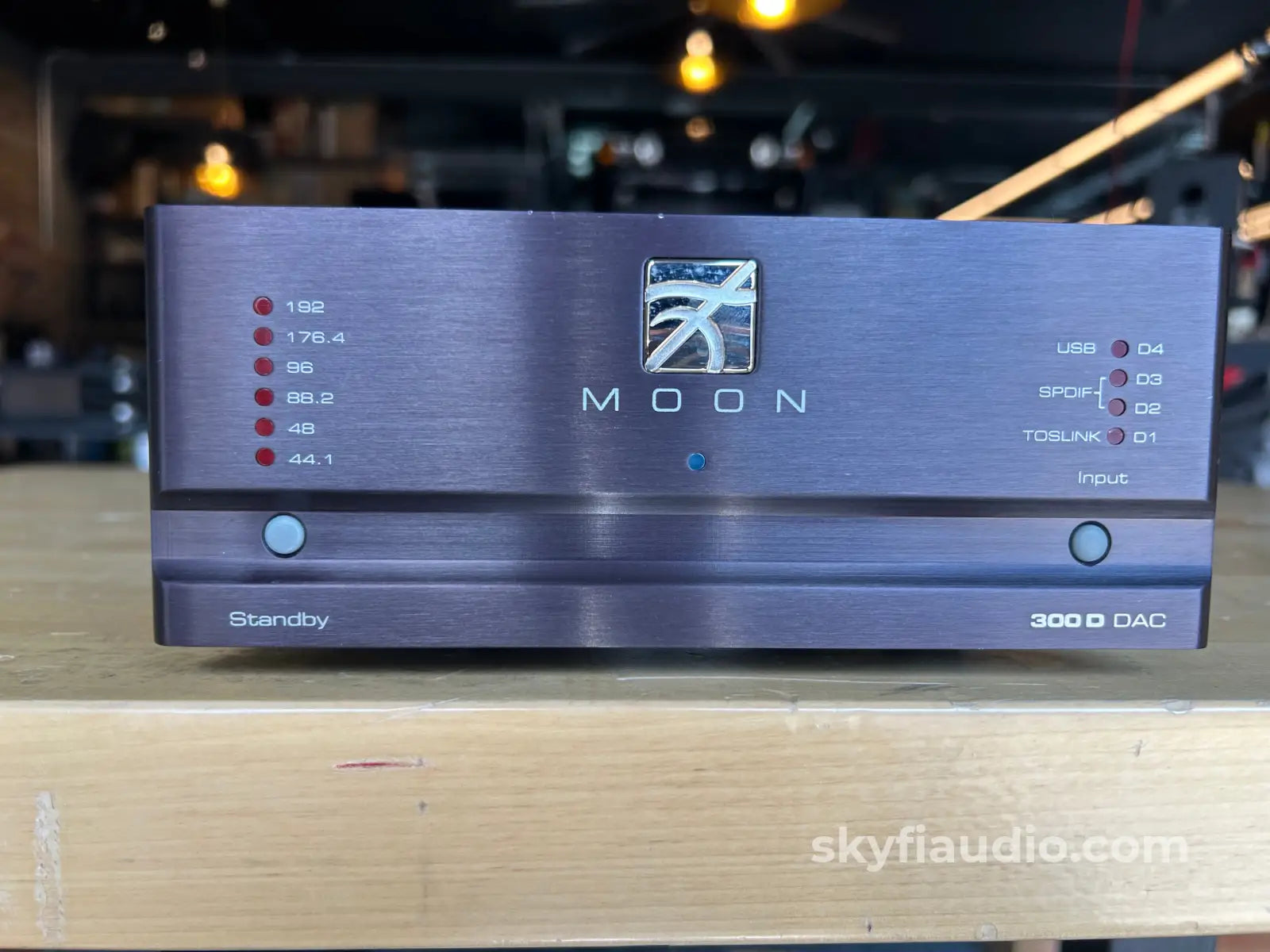
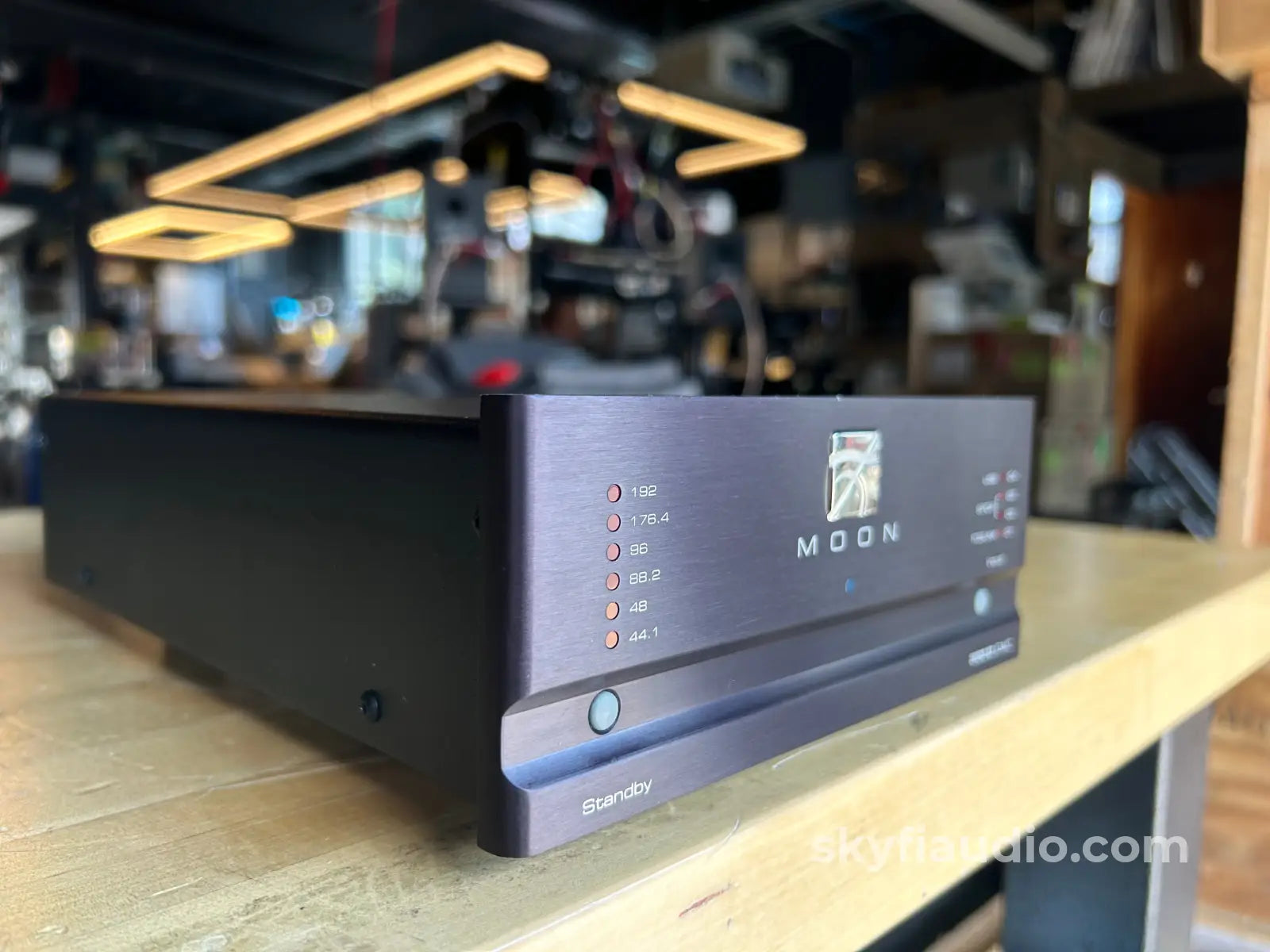
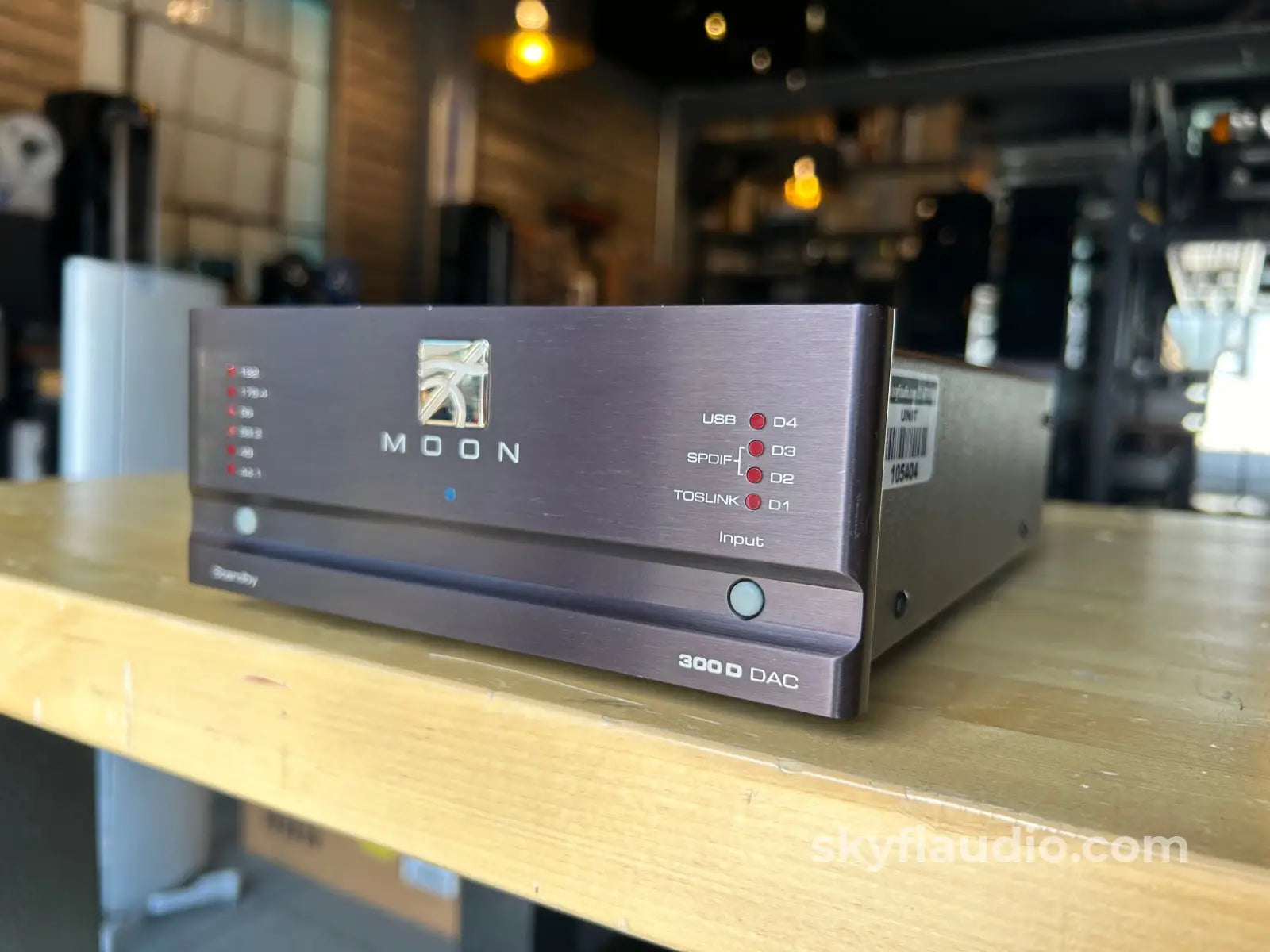
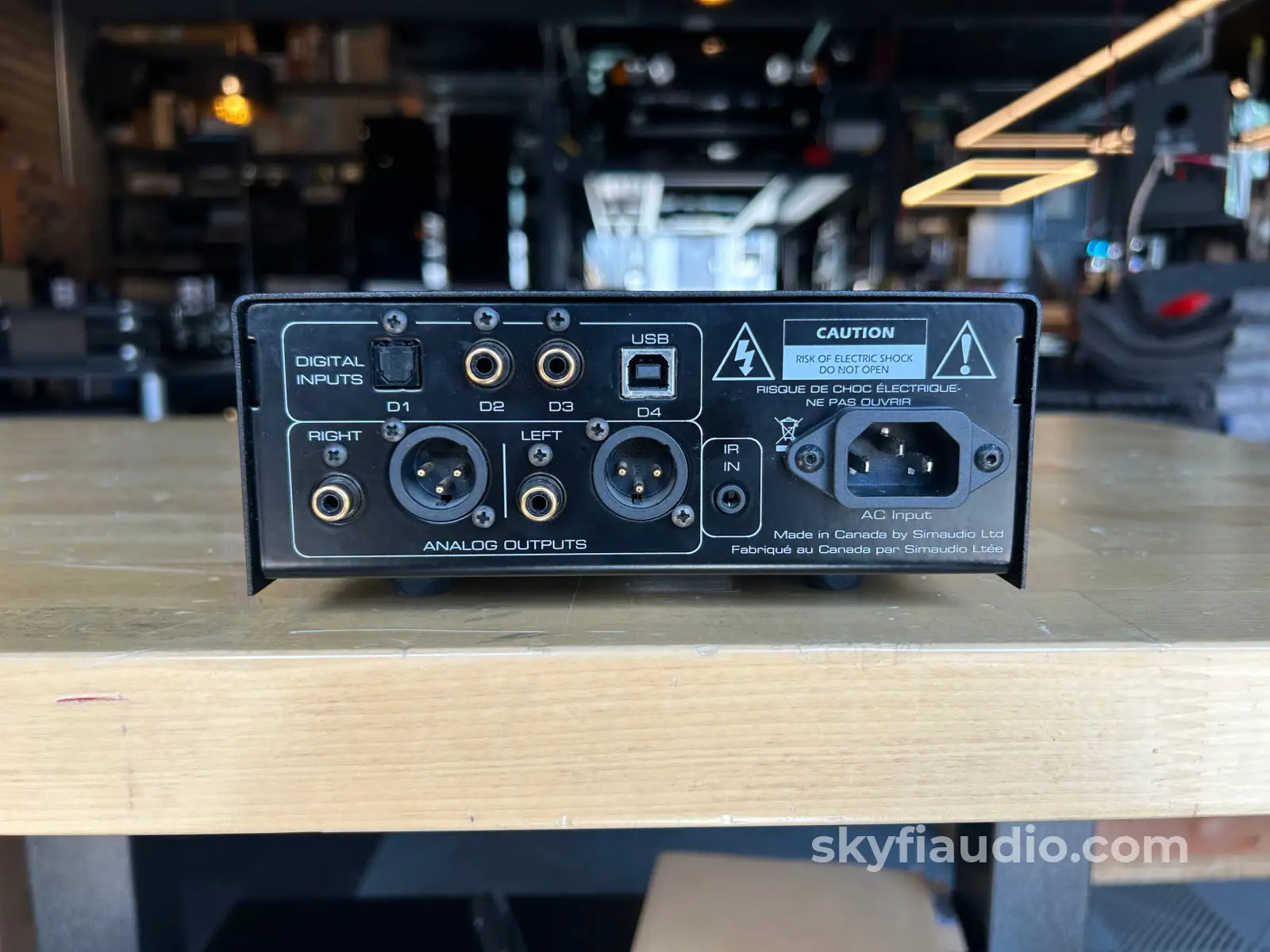
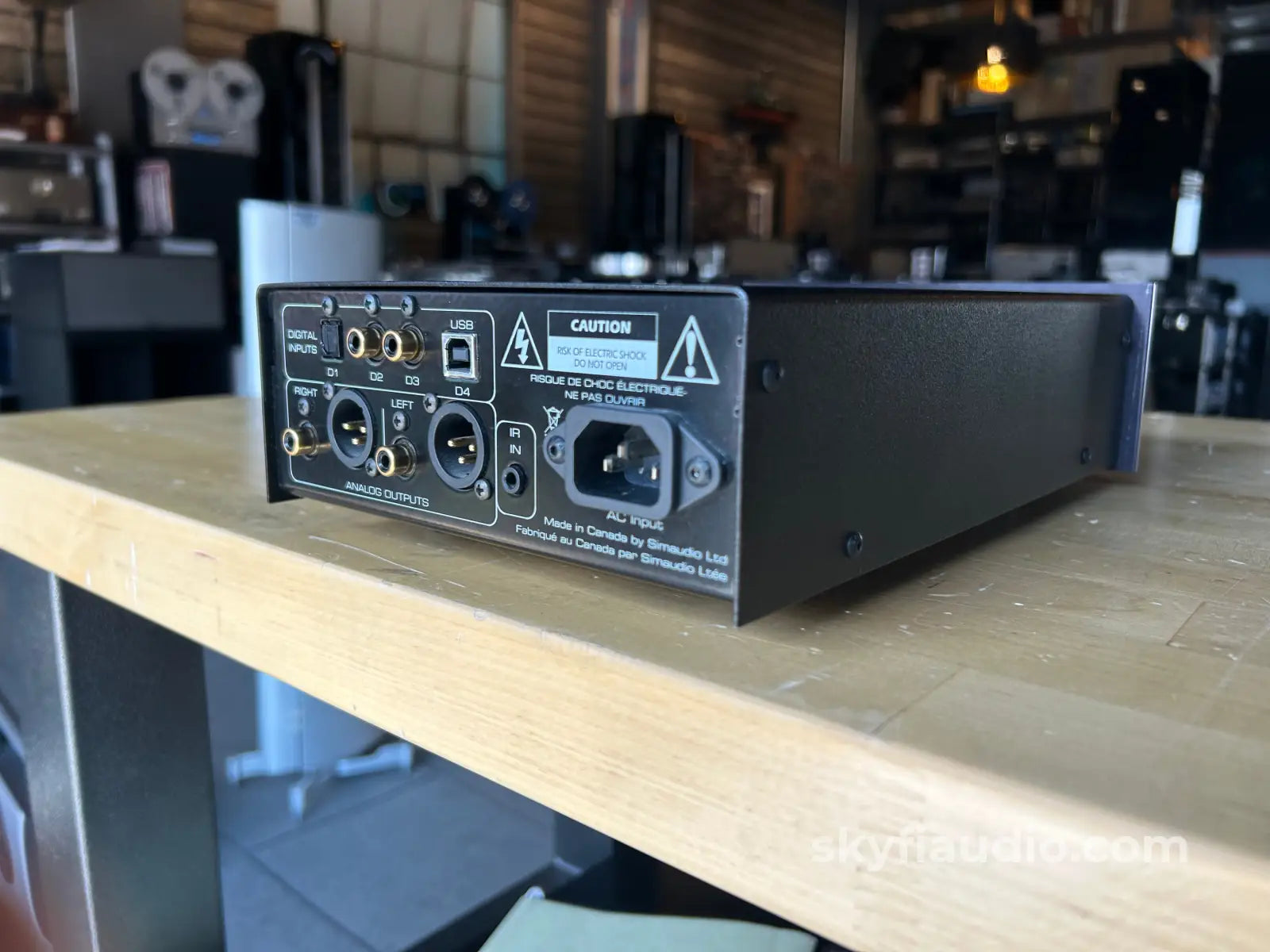
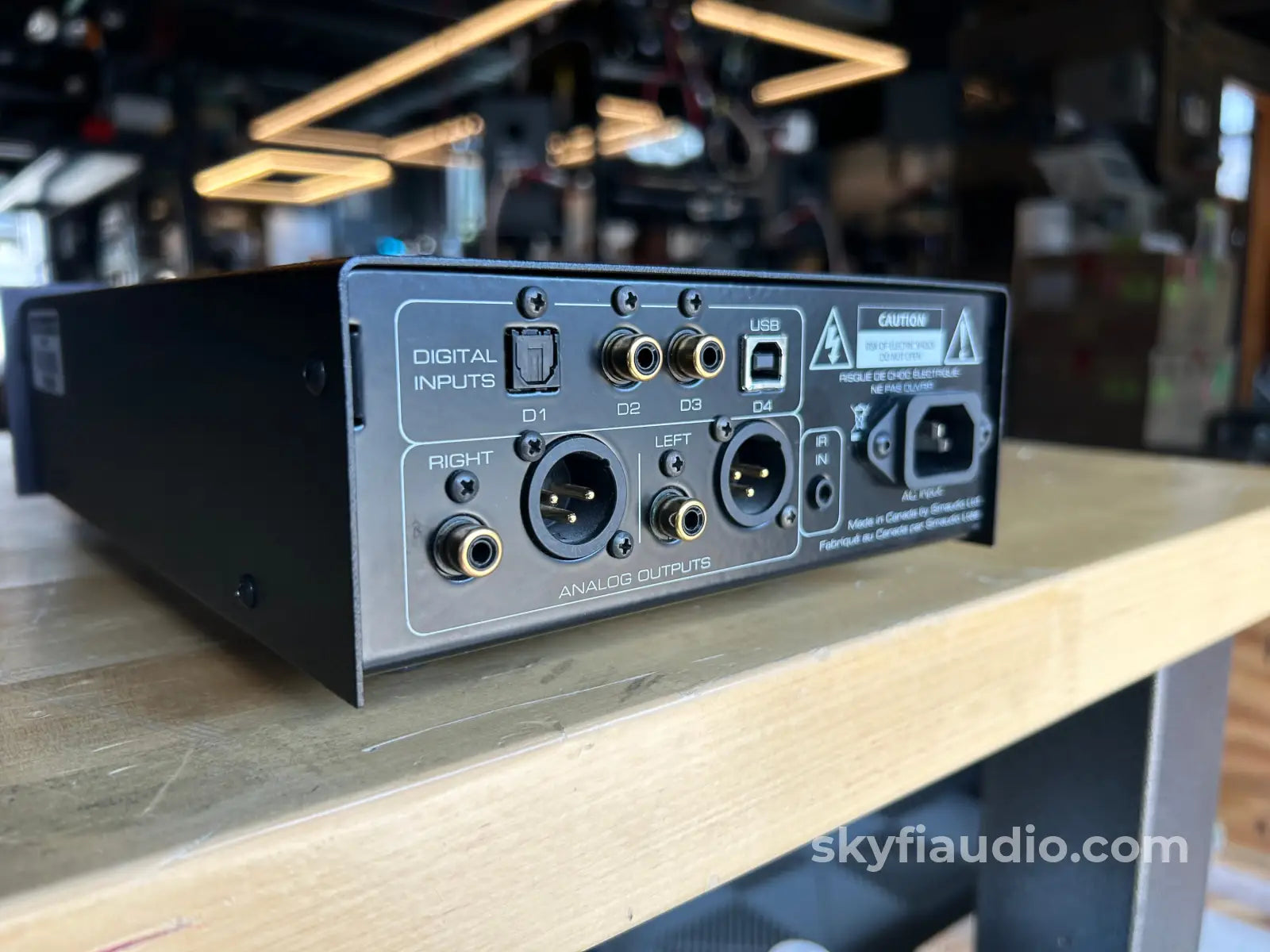
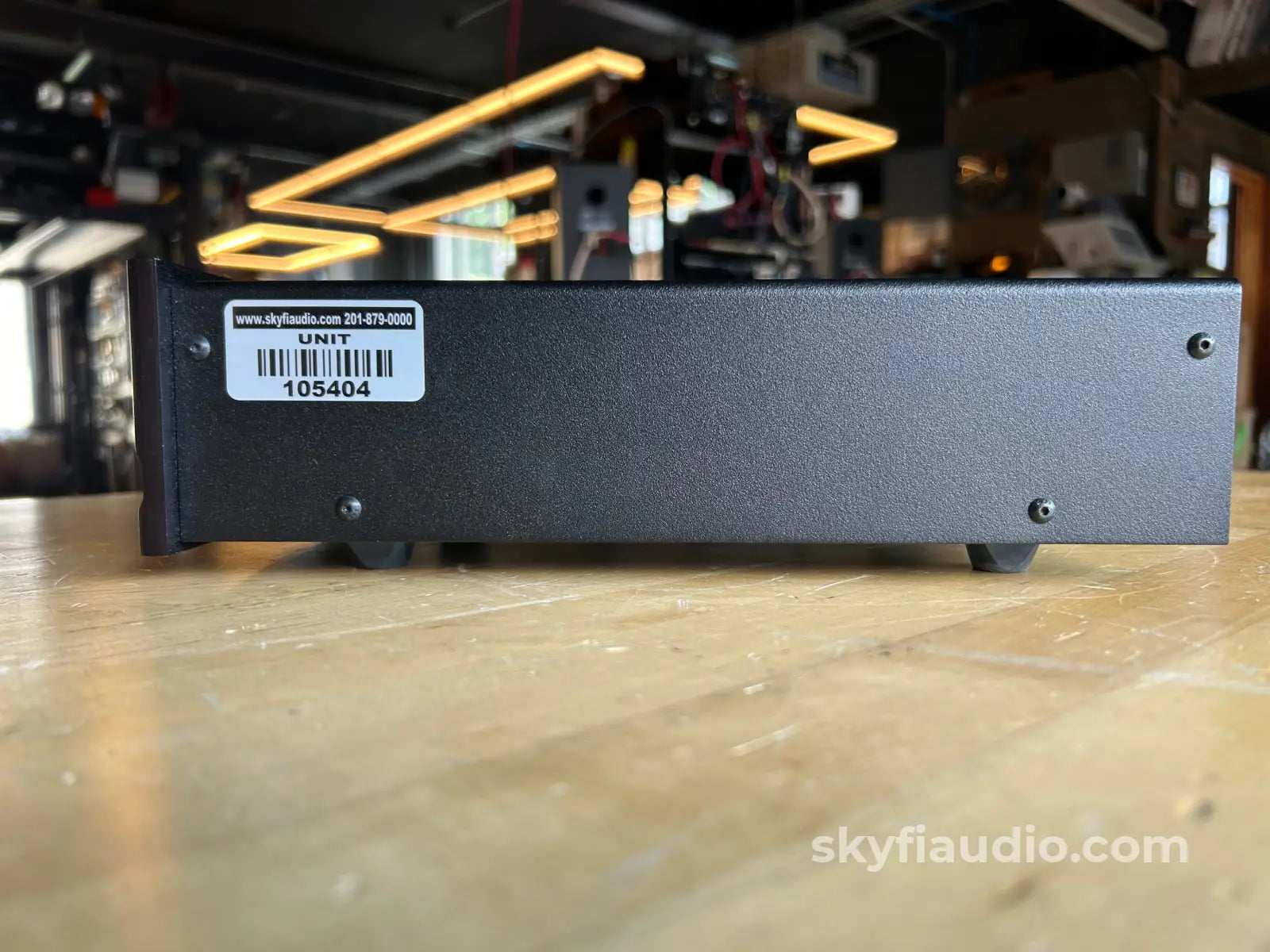
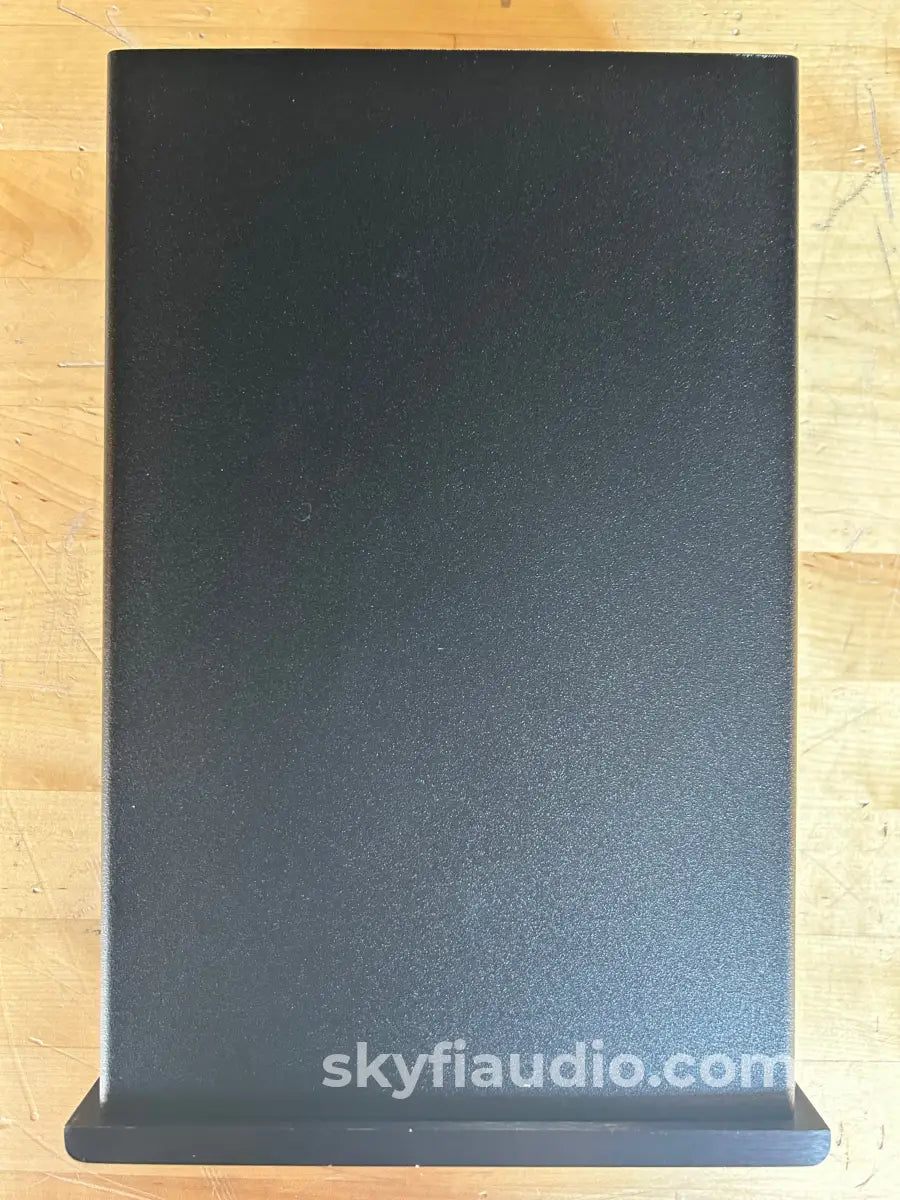
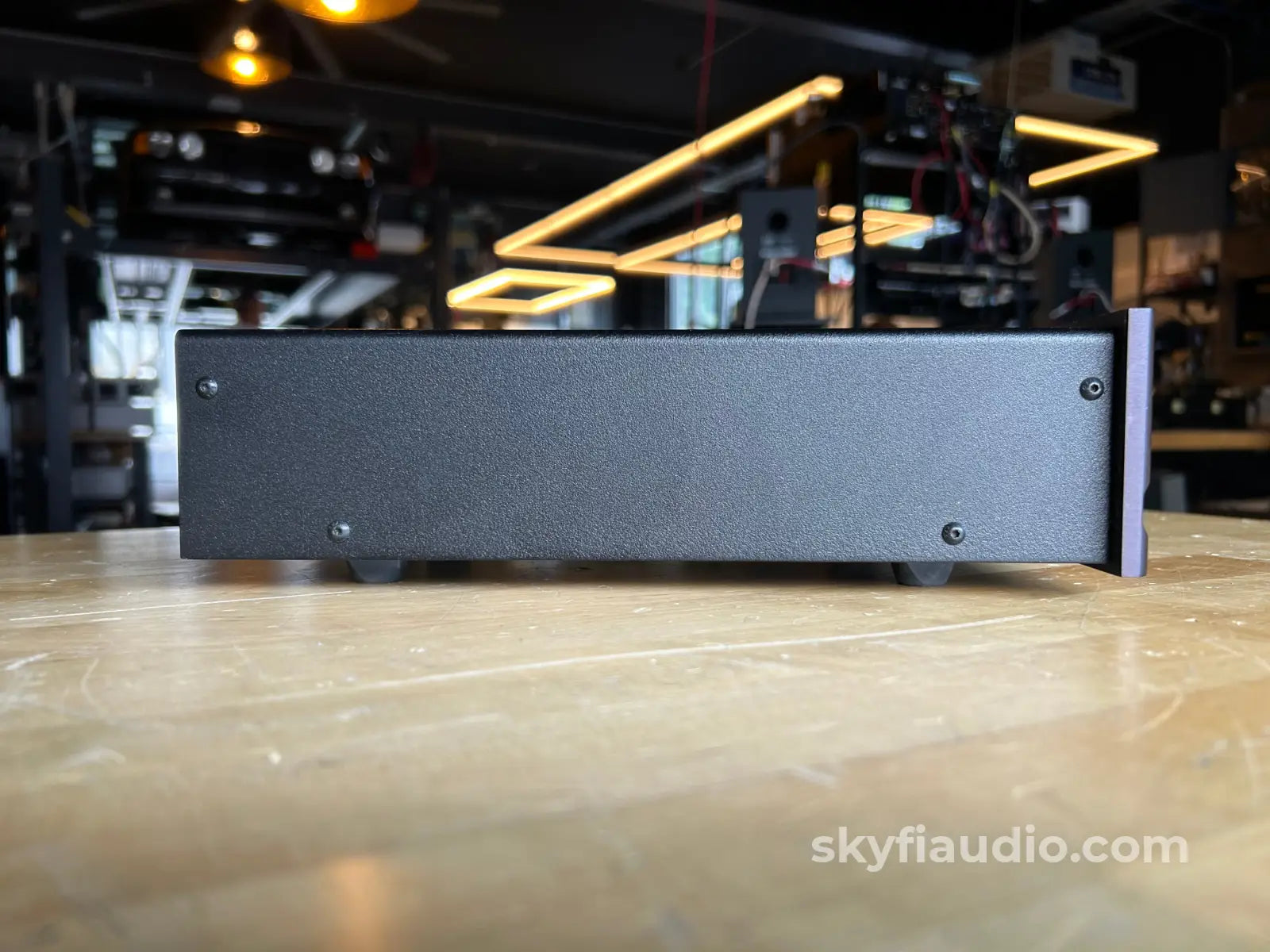
Simaudio Moon 300D Upsampling DAC
Free Shipping on Most Electronics - Excludes Speakers and Items Requiring Freight - Contiguous U.S. Only
Pickup currently unavailable at SkyFi 479

Simaudio Moon 300D Upsampling DAC
SkyFi 479
479 South Broad Street
Glen Rock NJ 07452
United States
General:
Standout Features for the Moon 300D v1 Upsampling DAC
• Burr Brown PCM1793 high-resolution 24-bit/192-kHz D/A and 8x oversampling
• Internal upsampling which uses 24-bit / 352.8kHz processing
• Oversized power supply with 8 stages of voltage regulation
• Single-ended RCA and Balanced XLR analog outputs
• Accurate digital clocking system for exceptionally low intrinsic jitter levels
• Advanced analog signal path using a DC servo circuit and proprietary analog filter
• Pure copper circuit board tracings with extremely low impedance characteristics
The MOON 300D Digital-to-Analog Converter features an exceptionally versatile external interface that allows for use with a computer, via its USB-B input, as well as other digital audio source components such as a music server, digital transport, etc. though either S/PDIF or optical TosLink connectors. Intended to fulfill the demands of the discerning music aficionado, the 300D will bring new life to all of your digital audio files, regardless of their storage format.
With internal upsampling using 24-bit/352.8kHz processing, the MOON 300D will reproduce your digital music in a genuine life-like fashion. This DAC will accept an input signal ranging from 44.1 to 192kHz, with a bit-depth range from 16 to 24-bits. Jitter is a virtual non-issue thanks to our highly regarded proprietary digital clocking system. The back panel features a total of 4 digital inputs (USB, SPDIF x 2, and TosLink) and both balanced (XLR) and single-ended (RCA) analog outputs. The balanced outputs provide a significant improvement in noise floor, dynamics and midrange transparency.
Sonically, it portrays all of the Simaudio hallmarks: clean, powerful, fast and extended bass combined with an open midrange and airy extended high frequencies. Like other MOON series components, the 300D includes an IR input, an over-built power supply and is housed in a extremely rigid custom-made chassis with a 3/8” brushed and anodized front panel.
An important note about the USB input:
The USB input on the MOON 300D accepts a digital audio signal of up to 16-bits/48kHz. This is the native specification of the USB input. However, if you require a higher sampling rate, there are ways to achieve this with the 300D.
Rather than including a USB input for sampling rates exceeeding 48kHz, we opted to provide the best possible power supply, D/A converter and analog stage in the MOON 300D at this price level. Also, keep in mind that USB wasn’t originally intended for use with hi-resolution audio; there are latency issues which compromise sound quality (i.e. jitter and phase errors, etc.). These could be minimized through dedicated costly circuitry, but this would significantly drive up the cost of the 300D without improving the sonic performance on any of the other inputs.
If you intend to use the MOON 300D’s USB input, it’s very likely that your computer is a data source for music. Today most computers with a built-in sound card will have either an S/PDIF (RCA connector) or Toslink (optical connector) digital audio output, thus eliminating the need for a USB input on the 300D. Furthermore, if you’re committed to getting the most out of the music stored on your computer, then in all likelihood you have installed an after-market soundcard in your computer. Virtually all of these soundcards have at least one S/PDIF, Optical or AES/EBU (XLR connector) digital output. At this point, USB connectivity becomes irrelevant. The USB input is there for convenience as opposed to performance.
In the event that you wish to use your computer’s USB connection with files greater than 48kHz, there are several relatively inexpensive after-market products; compact one-box USB-to-S/PDIF interfaces that will work with USB datastreams up to 24-bit, all the way up to 192kHz.
Cosmetic Condition:
8/10 = Very Good. Excellent front faceplate, one minor flaw on chassis side or top. See our detailed rating description here.
Working Condition:
Working perfectly and tested on our bench with both CD and DVD. XLR and RCA working as they should.
Specs:
Type: Solid State
Front Panel Controls: Standby / Input Selector
LED Indicators: Locked Sampling Frequency / Input
Digital Input Types: S/PDIF (RCA) x 2 USB x 1 TosLink x 1
Digital Input Impedance: S/PDIF 75 Ohms @ 0.5 Volts
DAC / Digital Filter: BurrBrown PCM1793
Bit-depth range: - S/PDIF, Toslink 16 - 24 bits
Bit-depth range: - USB 16 bits
Sampling Frequency Rate range: - S/PDIF, Toslink 32, 44.1, 48, 88.2, 96, 176.4 and 192kHz
Sampling Frequency Rate range: - USB 32 - 48kHz
Frequency Response (audible): 20Hz - 20kHz +0/-0.2dB
Frequency Response (full range): 2Hz - 72kHz +0/-3dB
THD @ 1kHz, 0dBFS (A-weighted): < 0.001 %
IMD < 0.004 %
Dynamic Range: > 116dB
Signal-to-noise ratio: > 115dB @ full output
Slew Rate: 50V/µs
Channel Separation: > 115dB
Low Level Linearity: ±1.0dB to below 120dBFS
Intrinsic Jitter: < 25 picoseconds RMS
Single-ended Output: (RCA) 1 pair
Balanced Output: (XLR) 1 pair
Max. Analog Output: @ 0dBFS - RCA 2.0 Volts
Max. Analog Output: @ 0dBFS - XLR 2.0 Volts
Output Impedance: - Single-Ended 100 Ohms
Output Impedance: - Balanced 100 Ohms
IR input: 1/8" mini-jack
Power Consumption: 5 Watts
AC Power Requirements: 120V / 60Hz 240V / 50Hz
Fuse Replacement: - 120V 0.2A short slow blow
Fuse Replacement: - 230V 0.1A short slow blow
Dimensions:
7.5 x 3.25 x 11 in. (19 x 8 x 28 cm.)
Weight:
7 lbs.
Link to Manual:
Click Here
Recommended Cables:
Kimber Kable - RCA Interconnects - Better
Kimber Kable - BALANCED XLR Connectors - Better
Kimber Kable - Coaxial Digital Interconnect
Kimber Kable - Optical Digital Interconnect
Kimber Kable - Digital AES/EBU Interconnect
Kimber Kable - Select Series Reference USB Cable
Kimber Kable - Power Cords - Good
Kimber Kable - Power Cords - Better
Testing Process:
We start with a visual inspection of all internal components to make sure that there are no signs of heat stress or damage. Capacitors are checked for telltale signs of predictive failure including bulging, shrunken wrappers, or physical leakage. We also inspect resistors and other passive components for signs of overheating.
After the visual inspection we connect the DAC's RCA outputs to our Sencore PA81 Power Analyzer which simulates a real world input impedance and allows us to monitor the output on an oscilloscope. We are equipped to test optical, coaxial, and USB inputs at Redbook CD Quality.
We start with a test signal to verify signal lock and proper output on both channels. If the DAC has balanced outputs these are also tested at this time. If the DAC has multiple Optical and Coaxial inputs they are all checked for proper lock. USB inputs are tested with a MacBook Pro.
After proper function is verified, we setup the DAC for a listening test to evaluate general audio reproduction quality and monitor for clicks, pops, or any other audible signs of issues related to dropped signal lock or failing audio output stages. We often connect the DAC under evaluation to our long term test rig for a long test stint to verify stability under real world operating conditions.
Choose options









